Analyzing the Economic & Environmental Geography of Argentina
VerifiedAdded on 2023/05/28
|10
|1874
|356
Essay
AI Summary
This essay provides an overview of Argentina's economic, environmental, and population geography. It highlights Argentina's mixed economy, with a significant contribution from the business, service, and social sectors, as well as manufacturing. The essay also addresses environmental issues such as pollution and deforestation, linking deforestation to soybean plantation and cattle raising. The population geography section details the country's demographics, including population size, distribution, and ethnic groups, noting the predominantly European origin of the population and the challenges related to deforestation and environmental pollution. The study uses data and forecasts to predict future population trends and emphasizes the need for sustainable practices to balance economic growth with environmental protection. Desklib offers additional resources and solved assignments for students.
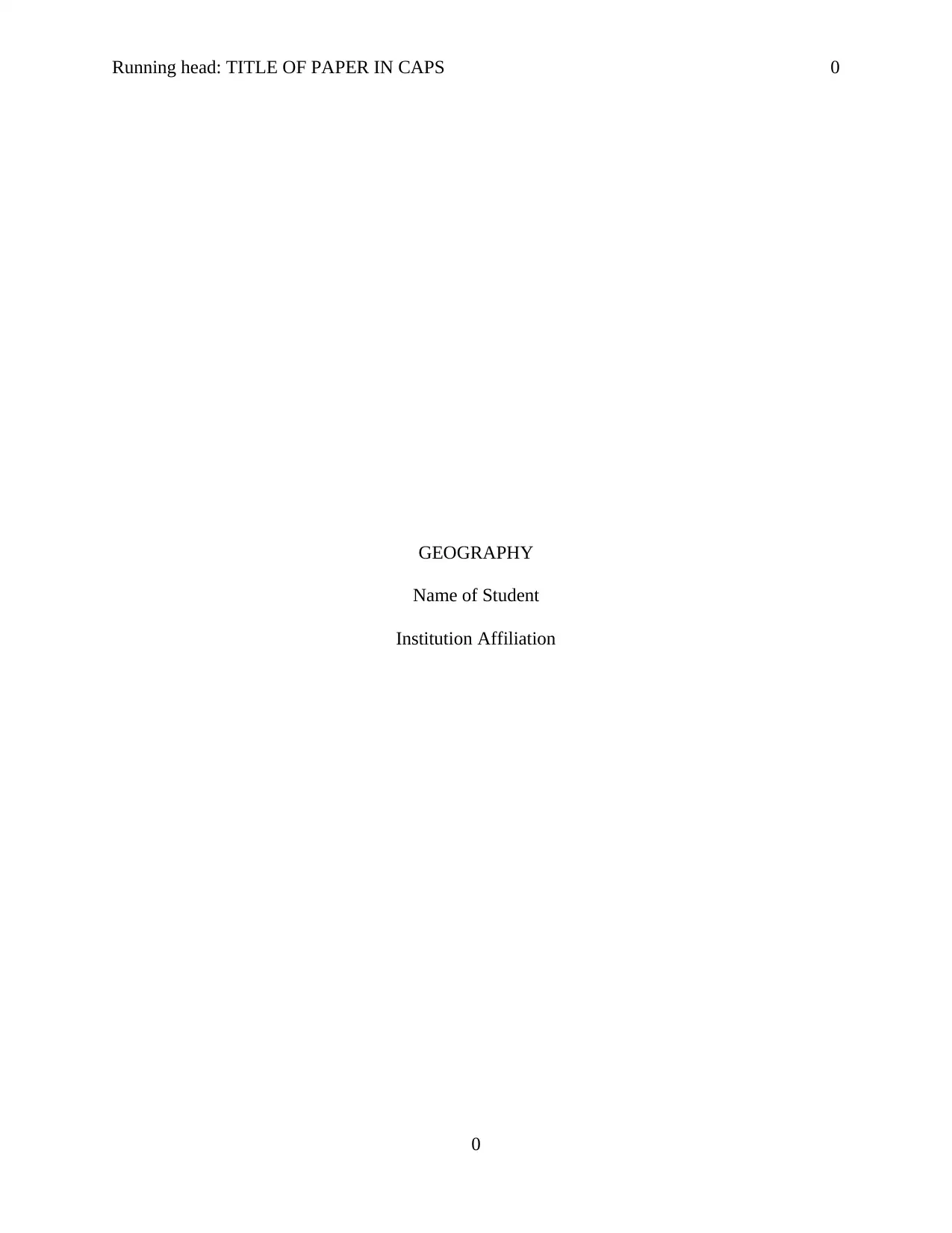
Running head: TITLE OF PAPER IN CAPS 0
GEOGRAPHY
Name of Student
Institution Affiliation
0
GEOGRAPHY
Name of Student
Institution Affiliation
0
Paraphrase This Document
Need a fresh take? Get an instant paraphrase of this document with our AI Paraphraser
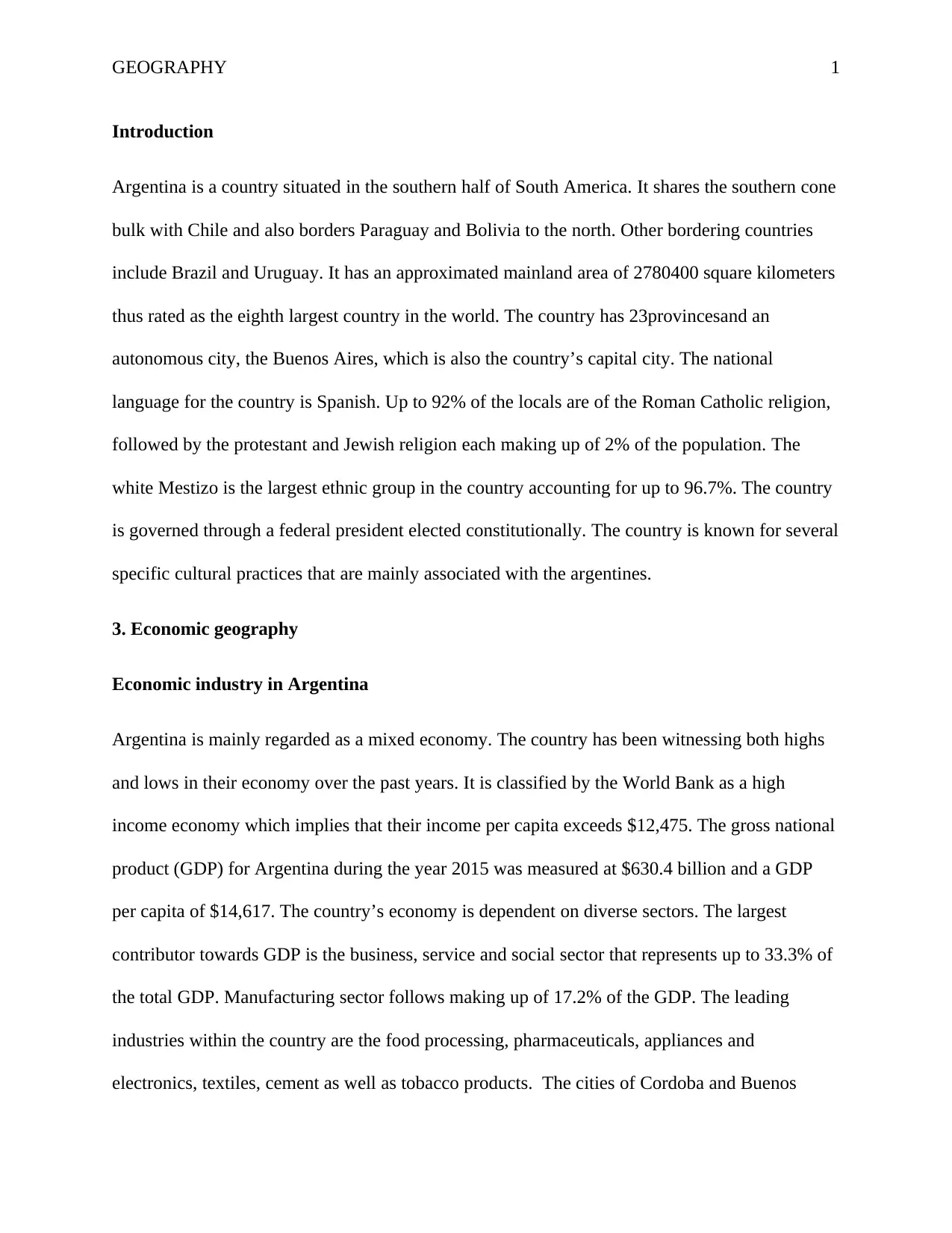
GEOGRAPHY 1
Introduction
Argentina is a country situated in the southern half of South America. It shares the southern cone
bulk with Chile and also borders Paraguay and Bolivia to the north. Other bordering countries
include Brazil and Uruguay. It has an approximated mainland area of 2780400 square kilometers
thus rated as the eighth largest country in the world. The country has 23provincesand an
autonomous city, the Buenos Aires, which is also the country’s capital city. The national
language for the country is Spanish. Up to 92% of the locals are of the Roman Catholic religion,
followed by the protestant and Jewish religion each making up of 2% of the population. The
white Mestizo is the largest ethnic group in the country accounting for up to 96.7%. The country
is governed through a federal president elected constitutionally. The country is known for several
specific cultural practices that are mainly associated with the argentines.
3. Economic geography
Economic industry in Argentina
Argentina is mainly regarded as a mixed economy. The country has been witnessing both highs
and lows in their economy over the past years. It is classified by the World Bank as a high
income economy which implies that their income per capita exceeds $12,475. The gross national
product (GDP) for Argentina during the year 2015 was measured at $630.4 billion and a GDP
per capita of $14,617. The country’s economy is dependent on diverse sectors. The largest
contributor towards GDP is the business, service and social sector that represents up to 33.3% of
the total GDP. Manufacturing sector follows making up of 17.2% of the GDP. The leading
industries within the country are the food processing, pharmaceuticals, appliances and
electronics, textiles, cement as well as tobacco products. The cities of Cordoba and Buenos
Introduction
Argentina is a country situated in the southern half of South America. It shares the southern cone
bulk with Chile and also borders Paraguay and Bolivia to the north. Other bordering countries
include Brazil and Uruguay. It has an approximated mainland area of 2780400 square kilometers
thus rated as the eighth largest country in the world. The country has 23provincesand an
autonomous city, the Buenos Aires, which is also the country’s capital city. The national
language for the country is Spanish. Up to 92% of the locals are of the Roman Catholic religion,
followed by the protestant and Jewish religion each making up of 2% of the population. The
white Mestizo is the largest ethnic group in the country accounting for up to 96.7%. The country
is governed through a federal president elected constitutionally. The country is known for several
specific cultural practices that are mainly associated with the argentines.
3. Economic geography
Economic industry in Argentina
Argentina is mainly regarded as a mixed economy. The country has been witnessing both highs
and lows in their economy over the past years. It is classified by the World Bank as a high
income economy which implies that their income per capita exceeds $12,475. The gross national
product (GDP) for Argentina during the year 2015 was measured at $630.4 billion and a GDP
per capita of $14,617. The country’s economy is dependent on diverse sectors. The largest
contributor towards GDP is the business, service and social sector that represents up to 33.3% of
the total GDP. Manufacturing sector follows making up of 17.2% of the GDP. The leading
industries within the country are the food processing, pharmaceuticals, appliances and
electronics, textiles, cement as well as tobacco products. The cities of Cordoba and Buenos
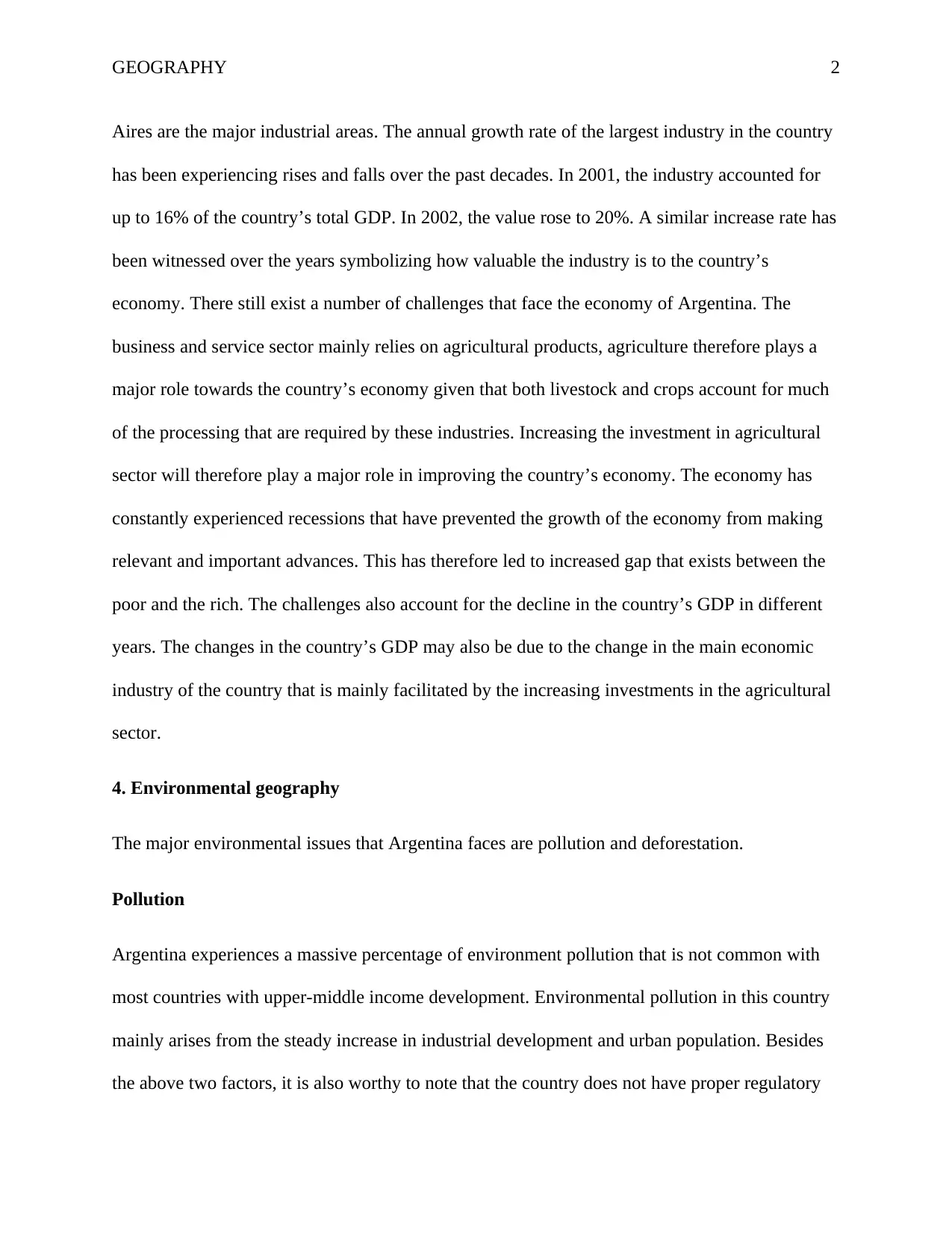
GEOGRAPHY 2
Aires are the major industrial areas. The annual growth rate of the largest industry in the country
has been experiencing rises and falls over the past decades. In 2001, the industry accounted for
up to 16% of the country’s total GDP. In 2002, the value rose to 20%. A similar increase rate has
been witnessed over the years symbolizing how valuable the industry is to the country’s
economy. There still exist a number of challenges that face the economy of Argentina. The
business and service sector mainly relies on agricultural products, agriculture therefore plays a
major role towards the country’s economy given that both livestock and crops account for much
of the processing that are required by these industries. Increasing the investment in agricultural
sector will therefore play a major role in improving the country’s economy. The economy has
constantly experienced recessions that have prevented the growth of the economy from making
relevant and important advances. This has therefore led to increased gap that exists between the
poor and the rich. The challenges also account for the decline in the country’s GDP in different
years. The changes in the country’s GDP may also be due to the change in the main economic
industry of the country that is mainly facilitated by the increasing investments in the agricultural
sector.
4. Environmental geography
The major environmental issues that Argentina faces are pollution and deforestation.
Pollution
Argentina experiences a massive percentage of environment pollution that is not common with
most countries with upper-middle income development. Environmental pollution in this country
mainly arises from the steady increase in industrial development and urban population. Besides
the above two factors, it is also worthy to note that the country does not have proper regulatory
Aires are the major industrial areas. The annual growth rate of the largest industry in the country
has been experiencing rises and falls over the past decades. In 2001, the industry accounted for
up to 16% of the country’s total GDP. In 2002, the value rose to 20%. A similar increase rate has
been witnessed over the years symbolizing how valuable the industry is to the country’s
economy. There still exist a number of challenges that face the economy of Argentina. The
business and service sector mainly relies on agricultural products, agriculture therefore plays a
major role towards the country’s economy given that both livestock and crops account for much
of the processing that are required by these industries. Increasing the investment in agricultural
sector will therefore play a major role in improving the country’s economy. The economy has
constantly experienced recessions that have prevented the growth of the economy from making
relevant and important advances. This has therefore led to increased gap that exists between the
poor and the rich. The challenges also account for the decline in the country’s GDP in different
years. The changes in the country’s GDP may also be due to the change in the main economic
industry of the country that is mainly facilitated by the increasing investments in the agricultural
sector.
4. Environmental geography
The major environmental issues that Argentina faces are pollution and deforestation.
Pollution
Argentina experiences a massive percentage of environment pollution that is not common with
most countries with upper-middle income development. Environmental pollution in this country
mainly arises from the steady increase in industrial development and urban population. Besides
the above two factors, it is also worthy to note that the country does not have proper regulatory
⊘ This is a preview!⊘
Do you want full access?
Subscribe today to unlock all pages.

Trusted by 1+ million students worldwide
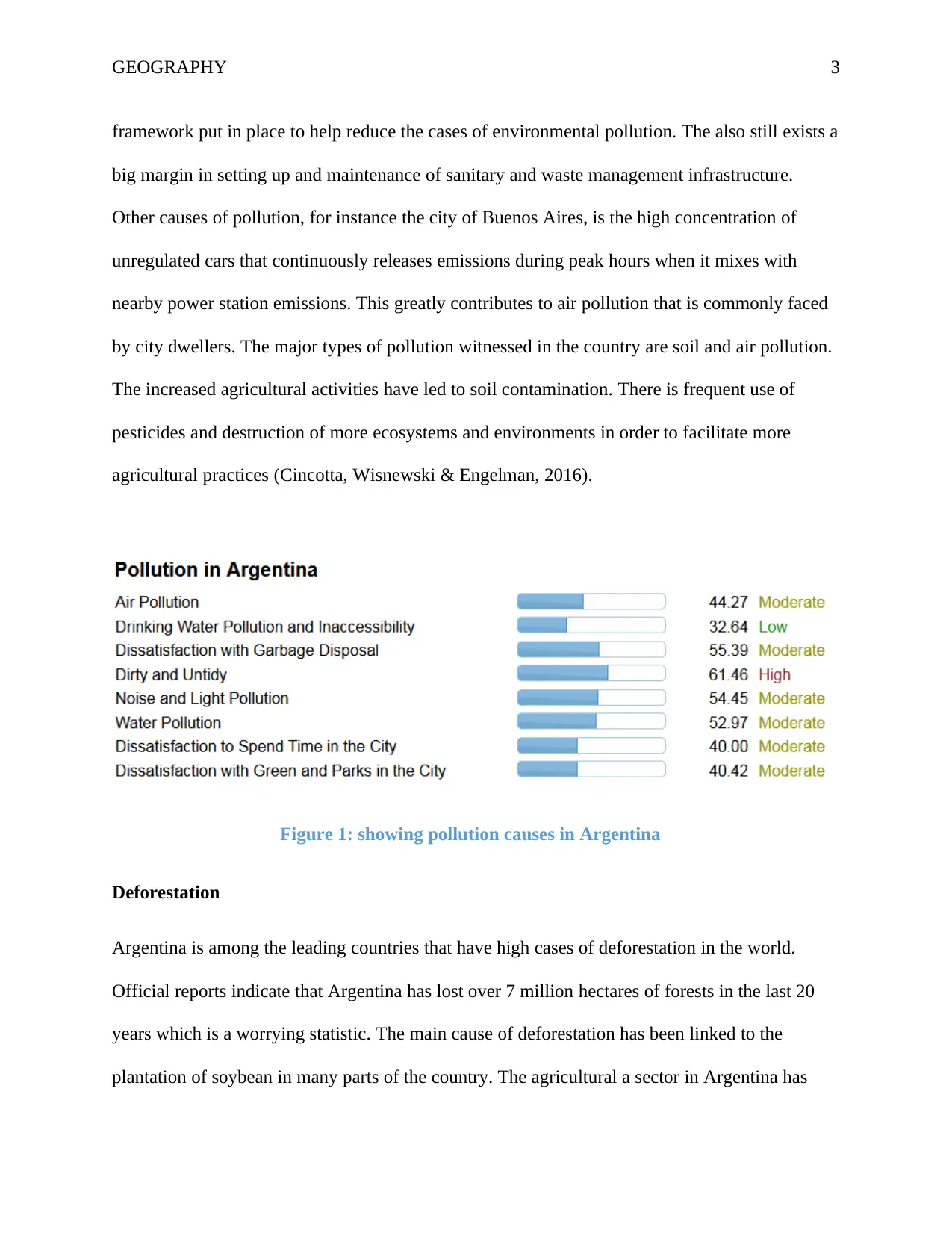
GEOGRAPHY 3
framework put in place to help reduce the cases of environmental pollution. The also still exists a
big margin in setting up and maintenance of sanitary and waste management infrastructure.
Other causes of pollution, for instance the city of Buenos Aires, is the high concentration of
unregulated cars that continuously releases emissions during peak hours when it mixes with
nearby power station emissions. This greatly contributes to air pollution that is commonly faced
by city dwellers. The major types of pollution witnessed in the country are soil and air pollution.
The increased agricultural activities have led to soil contamination. There is frequent use of
pesticides and destruction of more ecosystems and environments in order to facilitate more
agricultural practices (Cincotta, Wisnewski & Engelman, 2016).
Figure 1: showing pollution causes in Argentina
Deforestation
Argentina is among the leading countries that have high cases of deforestation in the world.
Official reports indicate that Argentina has lost over 7 million hectares of forests in the last 20
years which is a worrying statistic. The main cause of deforestation has been linked to the
plantation of soybean in many parts of the country. The agricultural a sector in Argentina has
framework put in place to help reduce the cases of environmental pollution. The also still exists a
big margin in setting up and maintenance of sanitary and waste management infrastructure.
Other causes of pollution, for instance the city of Buenos Aires, is the high concentration of
unregulated cars that continuously releases emissions during peak hours when it mixes with
nearby power station emissions. This greatly contributes to air pollution that is commonly faced
by city dwellers. The major types of pollution witnessed in the country are soil and air pollution.
The increased agricultural activities have led to soil contamination. There is frequent use of
pesticides and destruction of more ecosystems and environments in order to facilitate more
agricultural practices (Cincotta, Wisnewski & Engelman, 2016).
Figure 1: showing pollution causes in Argentina
Deforestation
Argentina is among the leading countries that have high cases of deforestation in the world.
Official reports indicate that Argentina has lost over 7 million hectares of forests in the last 20
years which is a worrying statistic. The main cause of deforestation has been linked to the
plantation of soybean in many parts of the country. The agricultural a sector in Argentina has
Paraphrase This Document
Need a fresh take? Get an instant paraphrase of this document with our AI Paraphraser
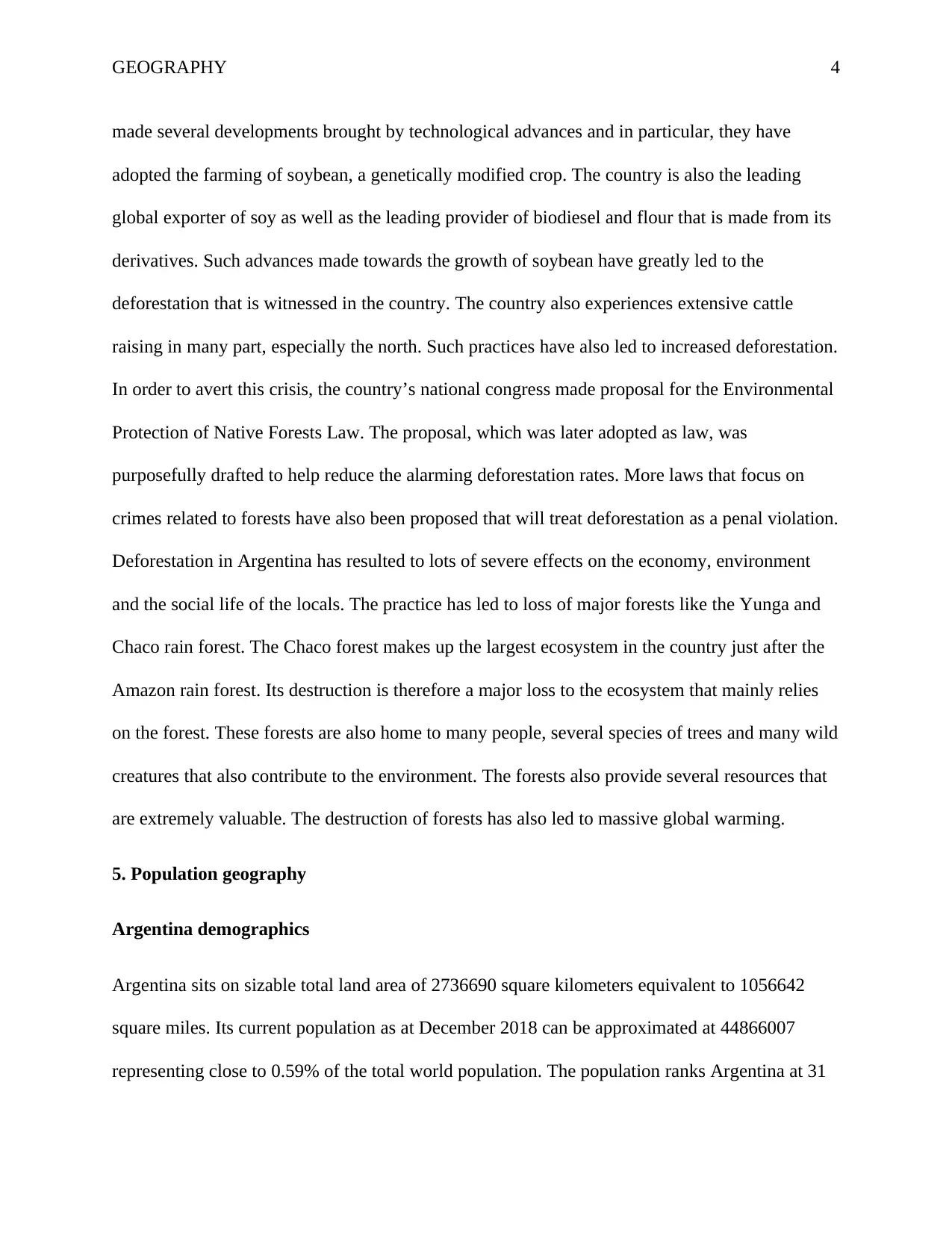
GEOGRAPHY 4
made several developments brought by technological advances and in particular, they have
adopted the farming of soybean, a genetically modified crop. The country is also the leading
global exporter of soy as well as the leading provider of biodiesel and flour that is made from its
derivatives. Such advances made towards the growth of soybean have greatly led to the
deforestation that is witnessed in the country. The country also experiences extensive cattle
raising in many part, especially the north. Such practices have also led to increased deforestation.
In order to avert this crisis, the country’s national congress made proposal for the Environmental
Protection of Native Forests Law. The proposal, which was later adopted as law, was
purposefully drafted to help reduce the alarming deforestation rates. More laws that focus on
crimes related to forests have also been proposed that will treat deforestation as a penal violation.
Deforestation in Argentina has resulted to lots of severe effects on the economy, environment
and the social life of the locals. The practice has led to loss of major forests like the Yunga and
Chaco rain forest. The Chaco forest makes up the largest ecosystem in the country just after the
Amazon rain forest. Its destruction is therefore a major loss to the ecosystem that mainly relies
on the forest. These forests are also home to many people, several species of trees and many wild
creatures that also contribute to the environment. The forests also provide several resources that
are extremely valuable. The destruction of forests has also led to massive global warming.
5. Population geography
Argentina demographics
Argentina sits on sizable total land area of 2736690 square kilometers equivalent to 1056642
square miles. Its current population as at December 2018 can be approximated at 44866007
representing close to 0.59% of the total world population. The population ranks Argentina at 31
made several developments brought by technological advances and in particular, they have
adopted the farming of soybean, a genetically modified crop. The country is also the leading
global exporter of soy as well as the leading provider of biodiesel and flour that is made from its
derivatives. Such advances made towards the growth of soybean have greatly led to the
deforestation that is witnessed in the country. The country also experiences extensive cattle
raising in many part, especially the north. Such practices have also led to increased deforestation.
In order to avert this crisis, the country’s national congress made proposal for the Environmental
Protection of Native Forests Law. The proposal, which was later adopted as law, was
purposefully drafted to help reduce the alarming deforestation rates. More laws that focus on
crimes related to forests have also been proposed that will treat deforestation as a penal violation.
Deforestation in Argentina has resulted to lots of severe effects on the economy, environment
and the social life of the locals. The practice has led to loss of major forests like the Yunga and
Chaco rain forest. The Chaco forest makes up the largest ecosystem in the country just after the
Amazon rain forest. Its destruction is therefore a major loss to the ecosystem that mainly relies
on the forest. These forests are also home to many people, several species of trees and many wild
creatures that also contribute to the environment. The forests also provide several resources that
are extremely valuable. The destruction of forests has also led to massive global warming.
5. Population geography
Argentina demographics
Argentina sits on sizable total land area of 2736690 square kilometers equivalent to 1056642
square miles. Its current population as at December 2018 can be approximated at 44866007
representing close to 0.59% of the total world population. The population ranks Argentina at 31
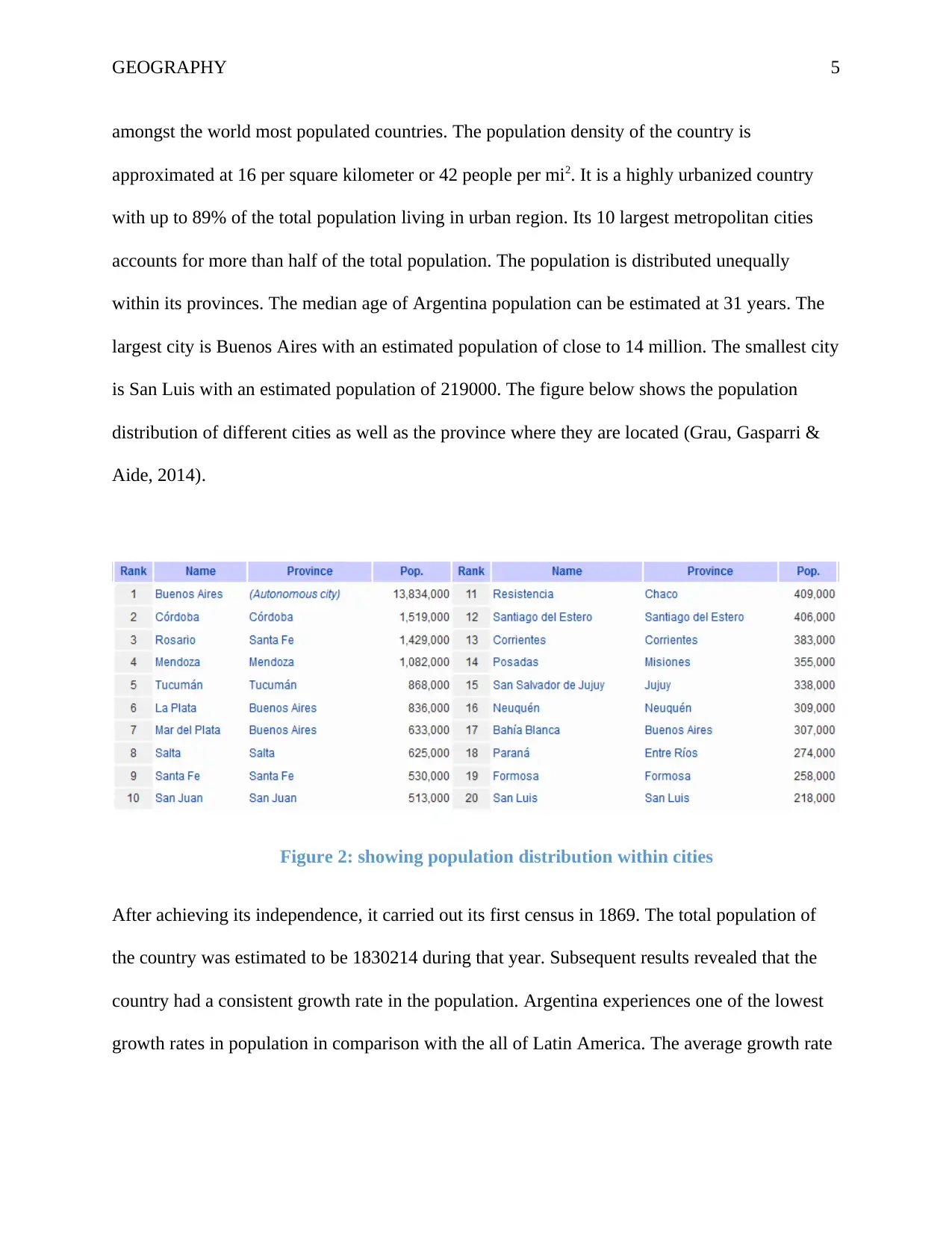
GEOGRAPHY 5
amongst the world most populated countries. The population density of the country is
approximated at 16 per square kilometer or 42 people per mi2. It is a highly urbanized country
with up to 89% of the total population living in urban region. Its 10 largest metropolitan cities
accounts for more than half of the total population. The population is distributed unequally
within its provinces. The median age of Argentina population can be estimated at 31 years. The
largest city is Buenos Aires with an estimated population of close to 14 million. The smallest city
is San Luis with an estimated population of 219000. The figure below shows the population
distribution of different cities as well as the province where they are located (Grau, Gasparri &
Aide, 2014).
Figure 2: showing population distribution within cities
After achieving its independence, it carried out its first census in 1869. The total population of
the country was estimated to be 1830214 during that year. Subsequent results revealed that the
country had a consistent growth rate in the population. Argentina experiences one of the lowest
growth rates in population in comparison with the all of Latin America. The average growth rate
amongst the world most populated countries. The population density of the country is
approximated at 16 per square kilometer or 42 people per mi2. It is a highly urbanized country
with up to 89% of the total population living in urban region. Its 10 largest metropolitan cities
accounts for more than half of the total population. The population is distributed unequally
within its provinces. The median age of Argentina population can be estimated at 31 years. The
largest city is Buenos Aires with an estimated population of close to 14 million. The smallest city
is San Luis with an estimated population of 219000. The figure below shows the population
distribution of different cities as well as the province where they are located (Grau, Gasparri &
Aide, 2014).
Figure 2: showing population distribution within cities
After achieving its independence, it carried out its first census in 1869. The total population of
the country was estimated to be 1830214 during that year. Subsequent results revealed that the
country had a consistent growth rate in the population. Argentina experiences one of the lowest
growth rates in population in comparison with the all of Latin America. The average growth rate
⊘ This is a preview!⊘
Do you want full access?
Subscribe today to unlock all pages.

Trusted by 1+ million students worldwide
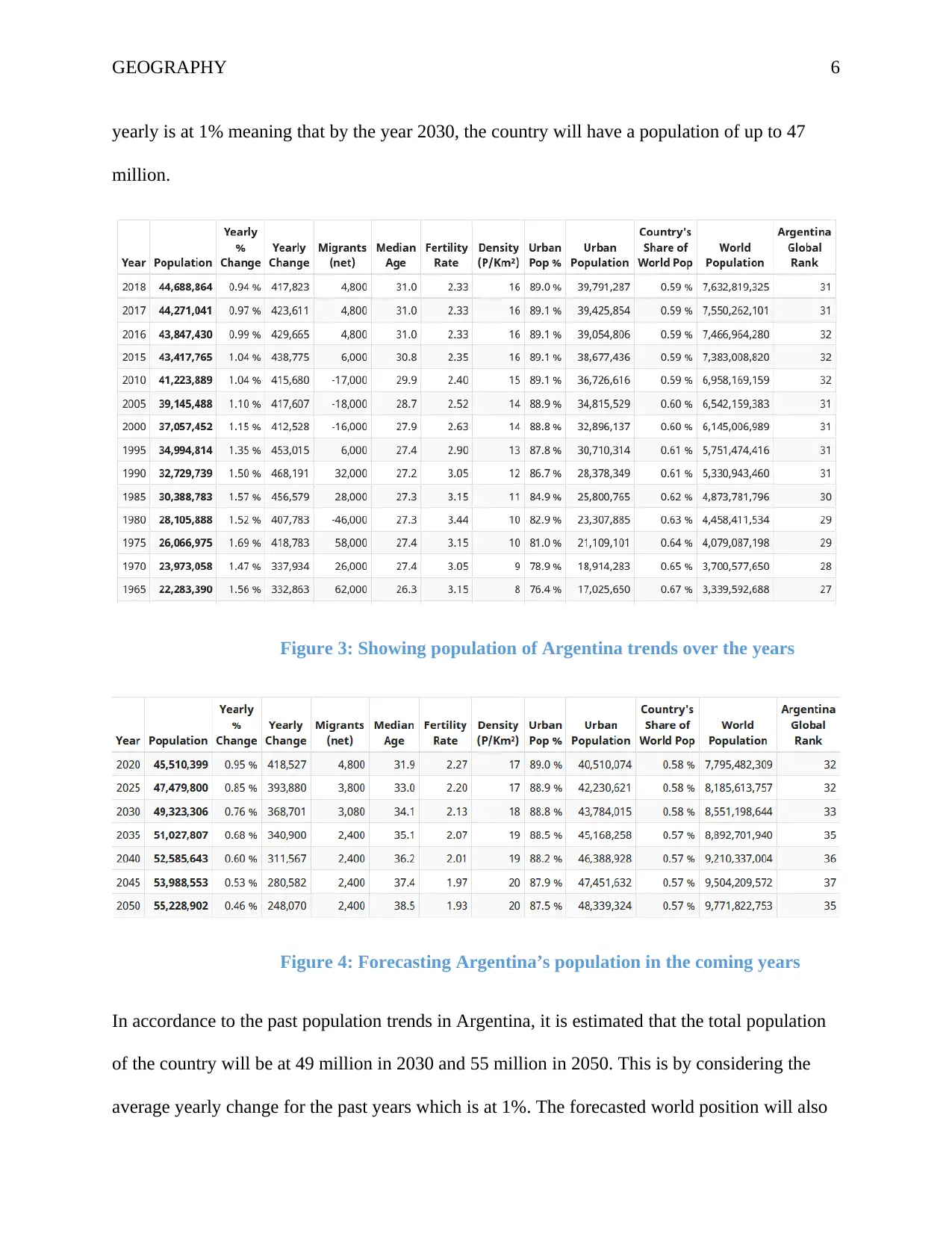
GEOGRAPHY 6
yearly is at 1% meaning that by the year 2030, the country will have a population of up to 47
million.
Figure 3: Showing population of Argentina trends over the years
Figure 4: Forecasting Argentina’s population in the coming years
In accordance to the past population trends in Argentina, it is estimated that the total population
of the country will be at 49 million in 2030 and 55 million in 2050. This is by considering the
average yearly change for the past years which is at 1%. The forecasted world position will also
yearly is at 1% meaning that by the year 2030, the country will have a population of up to 47
million.
Figure 3: Showing population of Argentina trends over the years
Figure 4: Forecasting Argentina’s population in the coming years
In accordance to the past population trends in Argentina, it is estimated that the total population
of the country will be at 49 million in 2030 and 55 million in 2050. This is by considering the
average yearly change for the past years which is at 1%. The forecasted world position will also
Paraphrase This Document
Need a fresh take? Get an instant paraphrase of this document with our AI Paraphraser
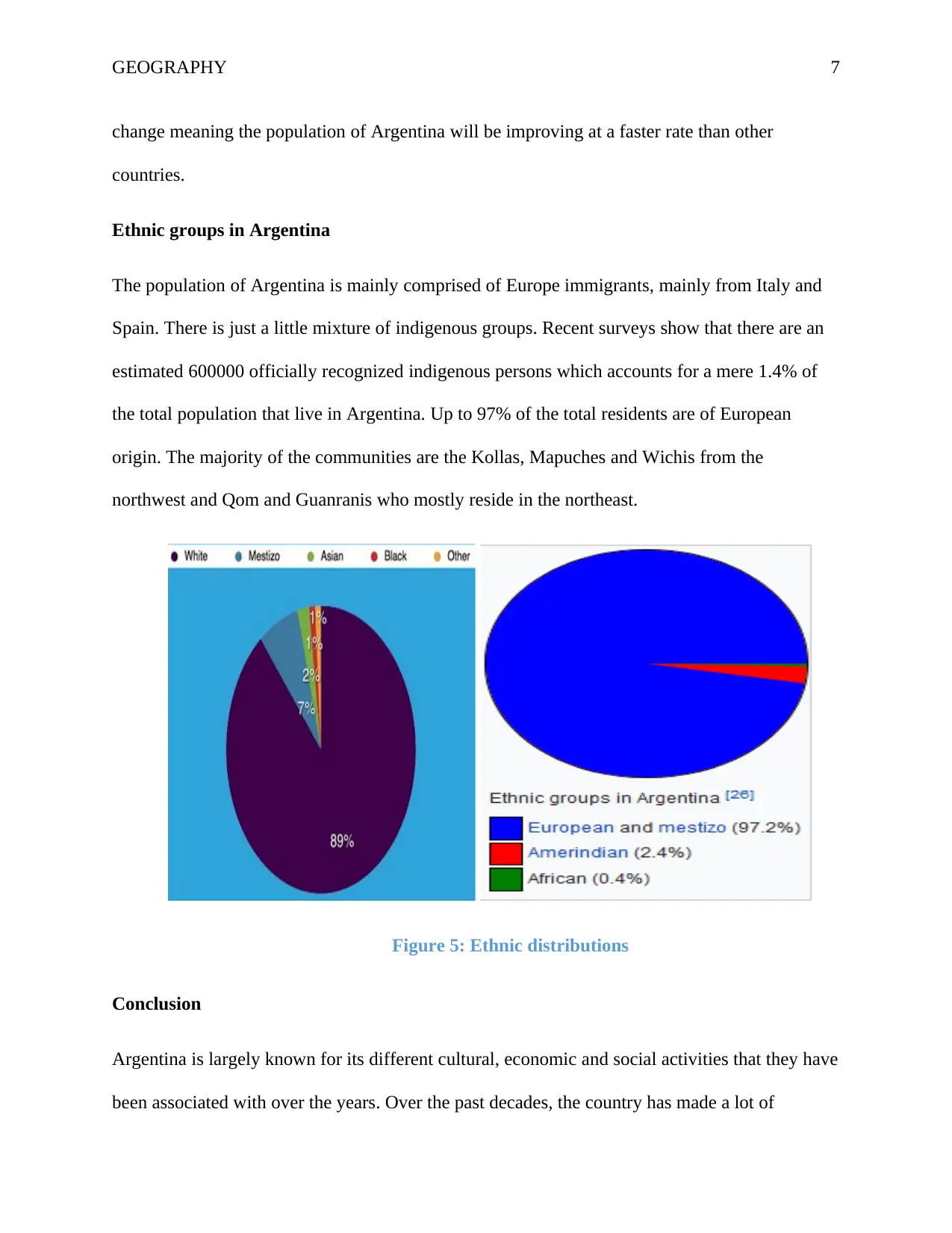
GEOGRAPHY 7
change meaning the population of Argentina will be improving at a faster rate than other
countries.
Ethnic groups in Argentina
The population of Argentina is mainly comprised of Europe immigrants, mainly from Italy and
Spain. There is just a little mixture of indigenous groups. Recent surveys show that there are an
estimated 600000 officially recognized indigenous persons which accounts for a mere 1.4% of
the total population that live in Argentina. Up to 97% of the total residents are of European
origin. The majority of the communities are the Kollas, Mapuches and Wichis from the
northwest and Qom and Guanranis who mostly reside in the northeast.
Figure 5: Ethnic distributions
Conclusion
Argentina is largely known for its different cultural, economic and social activities that they have
been associated with over the years. Over the past decades, the country has made a lot of
change meaning the population of Argentina will be improving at a faster rate than other
countries.
Ethnic groups in Argentina
The population of Argentina is mainly comprised of Europe immigrants, mainly from Italy and
Spain. There is just a little mixture of indigenous groups. Recent surveys show that there are an
estimated 600000 officially recognized indigenous persons which accounts for a mere 1.4% of
the total population that live in Argentina. Up to 97% of the total residents are of European
origin. The majority of the communities are the Kollas, Mapuches and Wichis from the
northwest and Qom and Guanranis who mostly reside in the northeast.
Figure 5: Ethnic distributions
Conclusion
Argentina is largely known for its different cultural, economic and social activities that they have
been associated with over the years. Over the past decades, the country has made a lot of
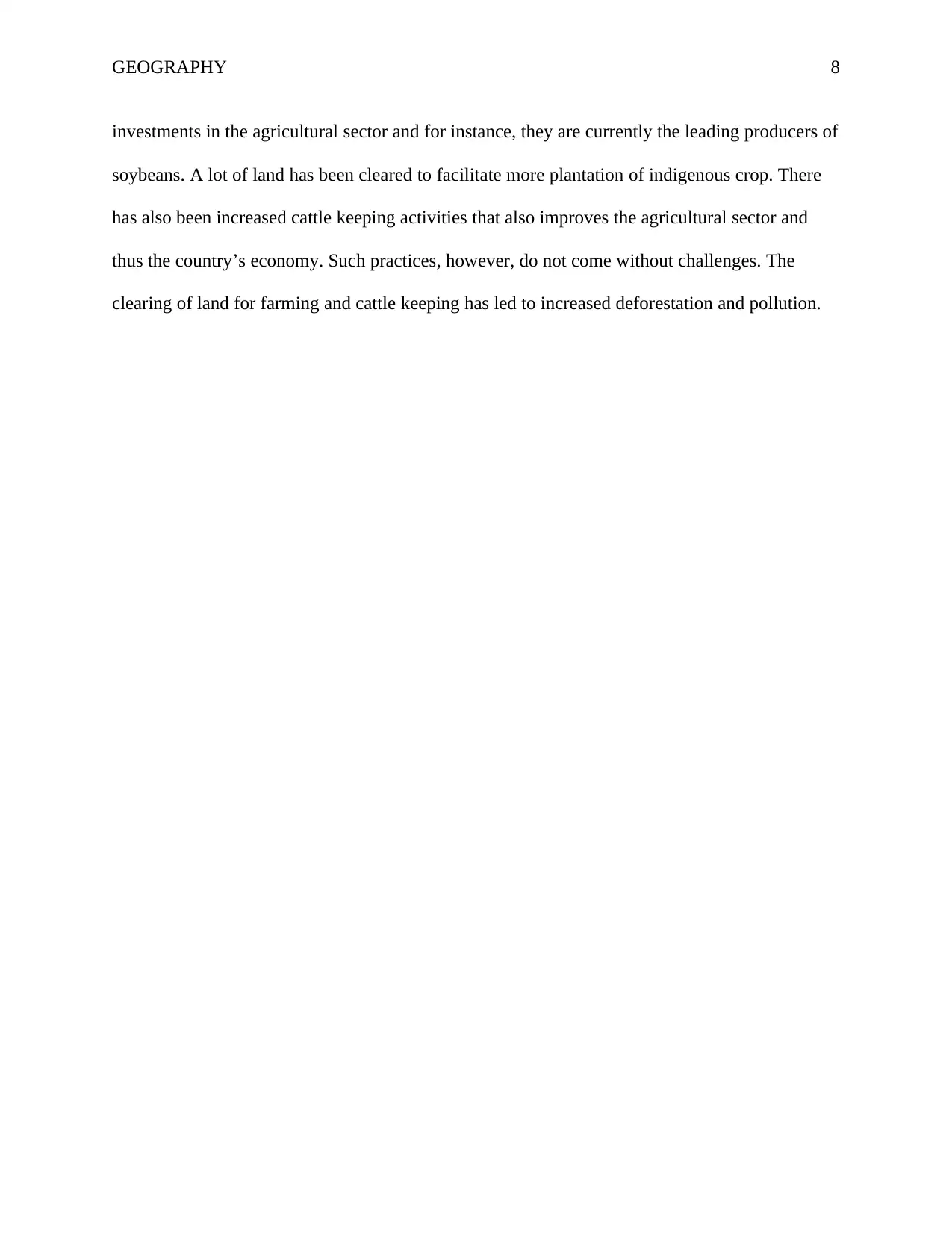
GEOGRAPHY 8
investments in the agricultural sector and for instance, they are currently the leading producers of
soybeans. A lot of land has been cleared to facilitate more plantation of indigenous crop. There
has also been increased cattle keeping activities that also improves the agricultural sector and
thus the country’s economy. Such practices, however, do not come without challenges. The
clearing of land for farming and cattle keeping has led to increased deforestation and pollution.
investments in the agricultural sector and for instance, they are currently the leading producers of
soybeans. A lot of land has been cleared to facilitate more plantation of indigenous crop. There
has also been increased cattle keeping activities that also improves the agricultural sector and
thus the country’s economy. Such practices, however, do not come without challenges. The
clearing of land for farming and cattle keeping has led to increased deforestation and pollution.
⊘ This is a preview!⊘
Do you want full access?
Subscribe today to unlock all pages.

Trusted by 1+ million students worldwide
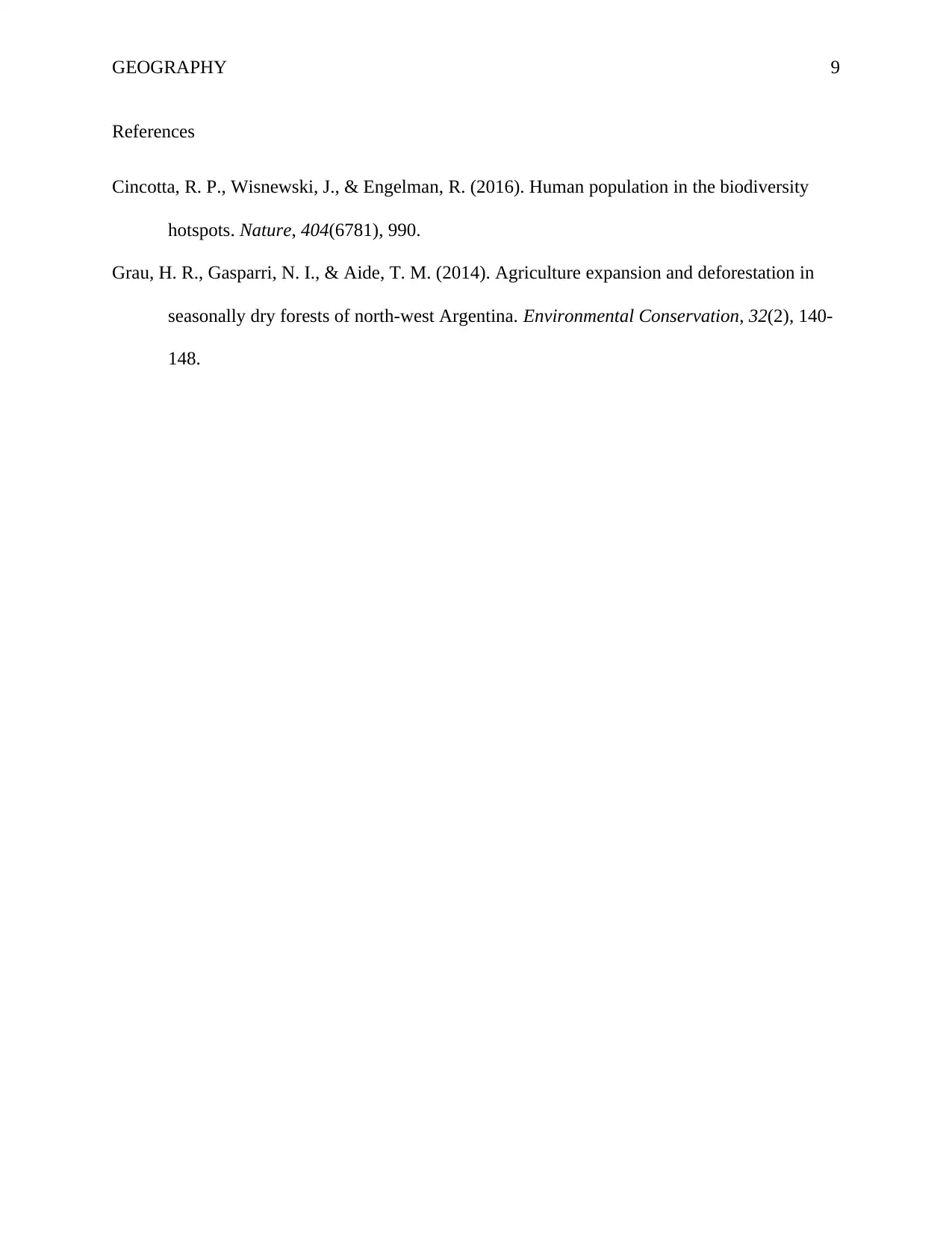
GEOGRAPHY 9
References
Cincotta, R. P., Wisnewski, J., & Engelman, R. (2016). Human population in the biodiversity
hotspots. Nature, 404(6781), 990.
Grau, H. R., Gasparri, N. I., & Aide, T. M. (2014). Agriculture expansion and deforestation in
seasonally dry forests of north-west Argentina. Environmental Conservation, 32(2), 140-
148.
References
Cincotta, R. P., Wisnewski, J., & Engelman, R. (2016). Human population in the biodiversity
hotspots. Nature, 404(6781), 990.
Grau, H. R., Gasparri, N. I., & Aide, T. M. (2014). Agriculture expansion and deforestation in
seasonally dry forests of north-west Argentina. Environmental Conservation, 32(2), 140-
148.
1 out of 10
Related Documents
Your All-in-One AI-Powered Toolkit for Academic Success.
+13062052269
info@desklib.com
Available 24*7 on WhatsApp / Email
![[object Object]](/_next/static/media/star-bottom.7253800d.svg)
Unlock your academic potential
Copyright © 2020–2025 A2Z Services. All Rights Reserved. Developed and managed by ZUCOL.





